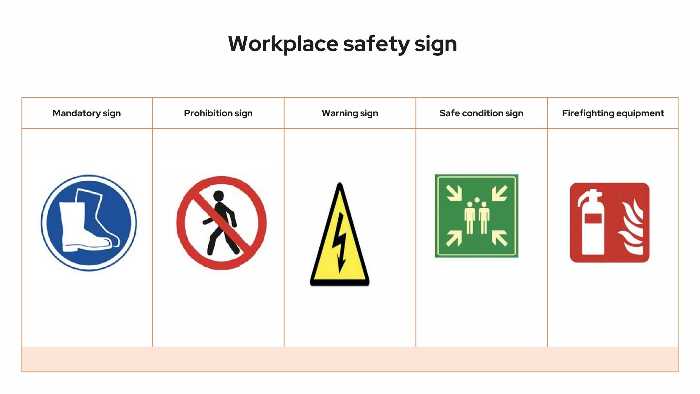We live surrounded by signs of very different types, but in this toolbox topic “workplace safety sign”, we are going to brief the signs that are used in the workplace. These signs are used for the prevention of occupational risks (prevent accidents at work). Technically they are called “Occupational Health and Safety Signage ".
What are workplace Safety Signs?
Safety Signs are signs that refer to a specific object, activity, or situation, and provide an indication or an obligation related to safety or health at work. There are five types of safety signages:
- Mandatory Signs,
- Warning signs,
- Prohibition Signs
- Safe condition and
- Fire Equipment Signs (fire safety sign)
All these signs play a vital role in communicating safety information. They can minimize the risk of an accident occurring in a workplace and are an easy and understandable way to get your message across to everyone. However, our duty to provide information to you about the meaning and requirements of all signs used in the workplace. So today we chose the toolbox topic “workplace safety sign”.
Let's start today's topic "workplace safety sign" with what they indicate and the colors they use, but first, let's see a summary that will be very useful for us to learn the workplace safety sign including:
- To prevent accidents and injuries. workplace safety sign can alert workers to potential hazards in the workplace, such as electrical hazards, hazardous materials, or falling objects. This helps workers to be more aware of their surroundings and to take appropriate precautions to avoid accidents.
- To provide instructions for safe work practices and procedures. Workplace safety sign can remind workers of the proper way to use equipment, machinery, and processes. This helps to ensure that workers are working safely and efficiently.
- To indicate emergency exits, emergency equipment, and first aid stations. This information can be crucial in the event of an emergency, helping workers to evacuate safely or to access the medical attention they need.
Construction site safety sign
There are two reactions of people to the signs. Some are upset with the bans and want to do the opposite. They are people who do not like to be told what they should or should not do. Others realize that these signs have a meaning and that they are there for a reason. They take them as a friendly and remember them gratefully.
Colors:
- Blue for mandatory actions.
- Red is a prohibition sign color but circular.
- Yellow is the color of the warning.
- Green for safe condition.
- Red as the firefighting equipment but in a rectangular shape.
It is clear that the second reaction is the correct one. A "Don't smoke" sign isn't just put up to stop them from taking their smoke. They are put there to prevent them from starting a fire. Nobody believes that a big fire can start with a cigarette or a match, but according to reports, many, many fires start with a cigarette butt or a match, causing untold loss of money, injuries, and deaths. The intention of the sign is to help them, not to make them angry.
If there is a notice that says "Do not operate without guards", the notice says what it means. The machine you are on is not dangerous unless the guards are in place. If you don't pay attention to the sign because you think it isn't clearly saying what it means, you are setting yourself up for an accident.
Failure to heed the warning for any reason, operating the machine without guards, means exposing yourself to the chance of a serious accident. If you are people who like to live dangerously, don't do it. There are others who may suffer because of you. The notices have been placed where they are to avoid an accident or an injury. This is its true meaning.
For signs to be sufficiently effective, they must meet some considerations regarding their location, shape, color, or design. Thus, for example, they must be constructed with a material that resists shocks, their size must be adequate to guarantee visibility and understanding, and they must be placed at an appropriate height and position taking into account the angle of vision and possible obstacles.
May you like
Conclusion
To promote a culture of safety. Safety signs can help to create a workplace environment where safety is a top priority. When workers see safety signs displayed throughout the workplace, it sends the message that safety is important to the company and that it is the responsibility of everyone to work safely.
In addition to these general benefits, safety signs can also be used to meet specific regulatory requirements. For example, the Occupational Safety and Health Administration (OSHA) in the United States requires employers to provide safety signs in certain workplaces and situations.


